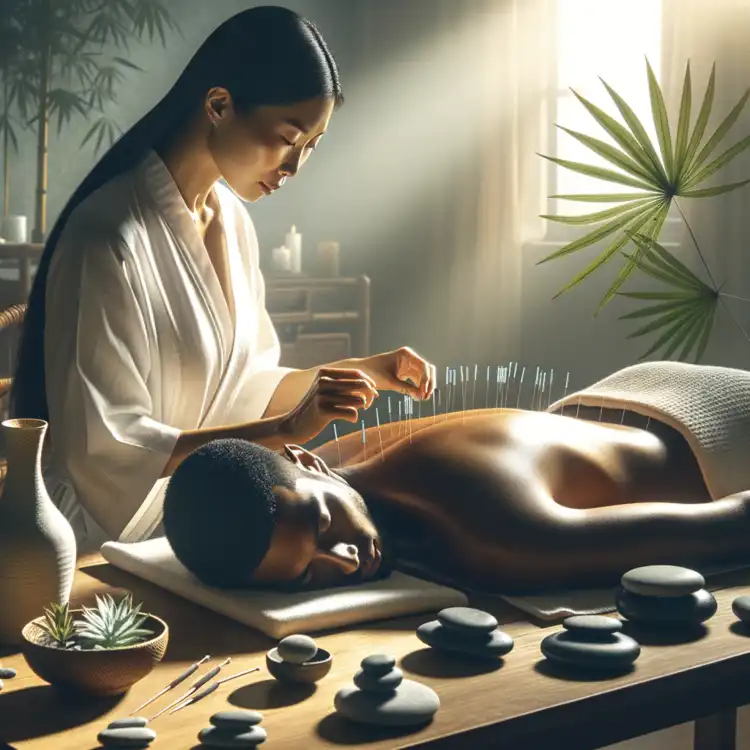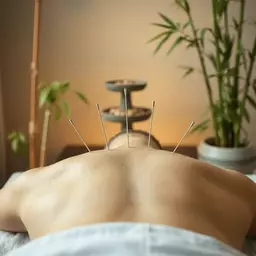Chronic Pain Management
80% of patients reported reduction in pain levels after treatment.
Subscribe to get the latest insights and updates straight to your inbox.
Posted on: 2025-04-22
By: Kaiya Whitmore
Acupuncture has been practiced for thousands of years, evolving into a respected form of therapy recognized for its effectiveness across a range of health issues. As this ancient art continues to gain traction in modern healthcare, understanding its history and mechanisms can empower patients and practitioners alike. What insights will you uncover about this transformative practice?
Acupuncture has been shown to have significant positive impacts on various health concerns, including chronic pain, mental health, and overall quality of life.
80% of patients reported reduction in pain levels after treatment.
70% of users reported decreases in anxiety levels.
85% of patients experienced enhanced daily functioning.
Acupuncture is more than just a treatment involving needles; it's a profound practice deeply rooted in history and tradition. At Acupuncture Perspectives, we explore the rich tapestry of this ancient art, delving into its mechanisms and effectiveness. By understanding the origins and principles behind acupuncture, we can appreciate its role in modern wellness and health.
Throughout this section, I’ll guide you through the historical background of acupuncture, how it works, and the intricate system of acupuncture points. This will provide a solid foundation for understanding its global effectiveness and usage. Let’s embark on this enlightening journey!
Acupuncture's origins can be traced back thousands of years to traditional Chinese medicine (TCM). It was developed based on the belief that vital energy, or qi, flows through our bodies along pathways called meridians. Ancient practitioners discovered that inserting thin needles at specific points could help restore balance and promote healing. For a deeper understanding of the theoretical underpinnings, see our article on Understanding Acupuncture and Chinese Medicine. By understanding the origins and principles behind acupuncture, we can appreciate its role in modern wellness and health. For a comprehensive overview of acupuncture, visit MedlinePlus
Over the centuries, acupuncture has evolved, adapting to various cultures while maintaining its core principles. Today, it is recognized not just as a treatment for pain, but as a holistic approach to wellness. It’s fascinating to see how this ancient practice has transcended time and geography, don’t you think?
The history of acupuncture is intertwined with the development of TCM, which dates back to the Han Dynasty (206 BCE – 220 CE). In its early days, acupuncture was primarily used to treat ailments through the lens of yin-yang balance and the five elements theory. This holistic view resonates even today, as many patients seek acupuncture for a range of health concerns.
Acupuncture gained popularity in various parts of Asia, with different countries adopting their own techniques and philosophies. For example, in Japan, practitioners often use a gentler approach, focusing on the patient’s comfort. This cultural adaptation illustrates how acupuncture can be tailored to meet diverse needs across the globe.
So, how does acupuncture actually work? The insertion of needles at specific points stimulates the body's nervous system, promoting the release of natural pain-relieving chemicals. This process can lead to an enhanced sense of well-being and reduced pain perception. Recent studies suggest that acupuncture may also influence various bodily systems, including the immune and endocrine systems. For a scientific understanding of acupuncture’s effectiveness and safety, see the National Center for Complementary and Integrative Health
Recent studies suggest that acupuncture may also influence various bodily systems, including the immune and endocrine systems. By understanding these mechanisms, we can appreciate why acupuncture is gaining recognition in mainstream healthcare as a complementary therapy. To learn more about acupuncture's benefits, read our piece on Insights on Acupuncture Benefits.
The meridian system is an essential concept in acupuncture, serving as a map of energy pathways in the body. There are over 350 acupuncture points, each associated with specific organs and conditions. Here’s a quick overview of some important acupuncture points:
Understanding these points not only enhances our practice but also empowers patients to engage with their treatment. Each session can be a unique journey, tailored to individual needs and experiences.
Now that we have a solid understanding of acupuncture’s history and mechanisms, let’s delve into its effectiveness and how it's being utilized around the world. With increasing recognition of its benefits, acupuncture is transforming from an ancient practice into a vital part of modern healthcare. For a look at how acupuncture is integrated into various cultures, explore our article on Cultural Perspectives on Acupuncture Practices.
As we explore research findings and case studies, we’ll uncover the profound impact acupuncture has on pain relief, inflammation, and even mental health issues. Stay tuned as we continue this exploration of acupuncture’s global journey!
Did you know? Consistency is key when it comes to experiencing the full benefits of acupuncture. Regular sessions can enhance the cumulative effects of treatment, leading to improved long-term health outcomes. Many practitioners recommend a series of sessions, especially for chronic conditions, to fully harness acupuncture's potential.
As we delve into the world of acupuncture, it becomes clear that this ancient practice has left a significant mark on global health. From my perspective at Acupuncture Perspectives, the stories of healing and recovery demonstrate how acupuncture is not just a treatment but a pathway to improved well-being. It’s fascinating to see how acupuncture is embraced across different cultures, highlighting its efficacy and cultural significance in diverse health practices. For a look at acupuncture's role in Western medicine, see Acupuncture's Role in Western Medicine.
When we think about the effectiveness of acupuncture, it’s essential to acknowledge its rich history and the wealth of research supporting its use. Across various studies, acupuncture has been shown to alleviate pain, reduce inflammation, and enhance overall quality of life. This is especially crucial for those seeking alternative methods to manage chronic conditions.
Looking to the future, research into acupuncture continues to evolve. I’m particularly excited about emerging studies that explore innovative techniques, such as electroacupuncture, which may offer even broader applications. These advancements indicate a promising future for acupuncture as a complementary practice within global healthcare. Learn more about global acupuncture practices in our in-depth article: Global Acupuncture Practices Uncovered.
As we consider the future of acupuncture, several key areas stand out for further exploration. These include:
At Acupuncture Perspectives, I believe that ongoing research is vital for validating acupuncture's effectiveness and expanding its acceptance. With greater understanding, we can bridge the gap between ancient practices and modern medicine, ultimately benefiting our community's health and wellness. For further expert insights, check out Insights on Acupuncture Benefits.
One of the most rewarding aspects of acupuncture is witnessing the positive changes in patients' lives. Many individuals report feeling a renewed sense of energy and relief from chronic symptoms after their treatments. It's inspiring to connect with patients who share their transformative experiences, showcasing how acupuncture can enhance their overall quality of life.
For example, consider the case of Sarah, who struggled with anxiety for years. After incorporating acupuncture into her routine, she noted a remarkable decrease in her stress levels, which allowed her to engage more fully in her daily activities. These stories highlight the profound impact acupuncture can have on personal journeys toward healing and wellness.
As the interest in acupuncture grows, so do the questions surrounding its practice. It's essential to provide clear answers to common inquiries, helping demystify this ancient art for newcomers and seasoned practitioners alike.
Acupuncture has a wide range of applications. Some of the most effective conditions include:
These are just a few areas where patients have seen substantial improvements, reflecting acupuncture's versatile nature.
Selecting a qualified acupuncturist is crucial for a positive experience. Here are some tips to consider:
Finding a practitioner who aligns with your health goals can make all the difference in your acupuncture journey.
Besides traditional acupuncture, there are other techniques worth exploring, such as:
Understanding these approaches can deepen your appreciation for the rich tapestry of healing methods available.
Now, it’s your turn! I invite you to share your experiences with acupuncture. Have you tried it? What was your journey like? Personal stories foster a sense of community and encourage others to explore this transformative healing practice.
Your stories can inspire others who are considering acupuncture. Whether it’s a tale of relief from chronic pain or a newfound balance in life, I would love to hear about it! Feel free to share your testimonials with Acupuncture Perspectives so we can continue to build a supportive community.
Lastly, let’s keep the conversation going! If there are specific topics you’d like to explore regarding acupuncture or holistic health, please let me know. Together, we can delve deeper into the fascinating world of acupuncture and its possibilities for enhancing well-being.
Here is a quick recap of the important points discussed in the article:

 Acupuncture, an ancient practice with roots in Traditional Chinese Medicine, has transcended cultura
Acupuncture, an ancient practice with roots in Traditional Chinese Medicine, has transcended cultura
 As the demand for alternative therapies grows, the need for well-trained acupuncturists becomes para
As the demand for alternative therapies grows, the need for well-trained acupuncturists becomes para
 As global health trends evolve, ancient practices like acupuncture are finding their place in modern
As global health trends evolve, ancient practices like acupuncture are finding their place in modern